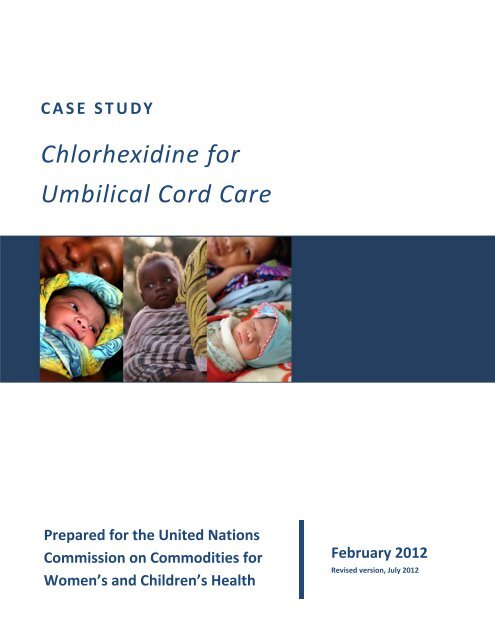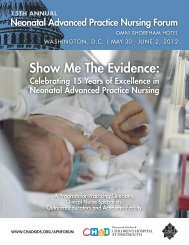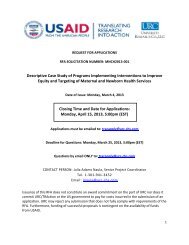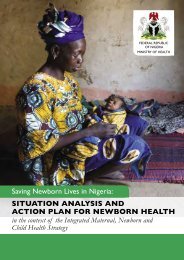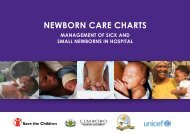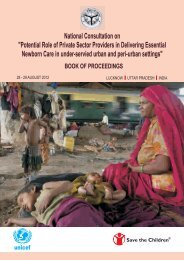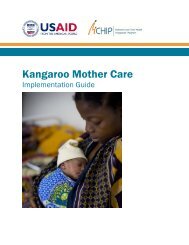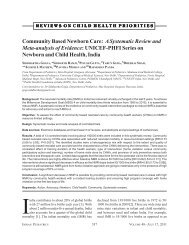Chlorhexidine for Umbilical Cord Care - Healthy Newborn Network
Chlorhexidine for Umbilical Cord Care - Healthy Newborn Network
Chlorhexidine for Umbilical Cord Care - Healthy Newborn Network
- No tags were found...
You also want an ePaper? Increase the reach of your titles
YUMPU automatically turns print PDFs into web optimized ePapers that Google loves.
CASE STUDY<strong>Chlorhexidine</strong> <strong>for</strong> <strong>Umbilical</strong> <strong>Cord</strong> <strong>Care</strong>Executive SummaryGlobally, neonatal infections are estimated to account <strong>for</strong> over 1 million newborn deaths annually(over a third of the total burden). In many regions, infection is the leading cause of neonatalmortality, and in high‐mortality regions infections are responsible <strong>for</strong> around half of all newborndeaths. Many of these infections come from contamination of the umbilical cord stump.<strong>Chlorhexidine</strong> digluconate is a widely used, low‐cost antiseptic effective against major agents ofneonatal infection. Since its introduction in the 1950s, it has been used regularly as a surgical anddetail antiseptic and carefully studied <strong>for</strong> safety and efficacy. Recent community‐level randomizedcontrolled trials in Nepal, Pakistan, and Bangladesh have shown that applying a 4% chlorhexidineproduct (7.1% chlorhexidine digluconate) to the umbilical cord saves lives (the Pakistan andBangladesh findings were published in The Lancet on February 8, 2012). Across the three countries,data from over 54,000 newborns showed an aggregate 23% reduction in neonatal mortality (notincluding deaths in the first few hours of life) and a 68% reduction in severe infections <strong>for</strong> thechlorhexidine intervention groups. These are some of the largest effect sizes seen in any neonatalintervention.There are literally dozens of manufacturers currently making chlorhexidine‐based products aroundthe world, at concentrations from
CASE STUDY<strong>Chlorhexidine</strong> <strong>for</strong> <strong>Umbilical</strong> <strong>Cord</strong> <strong>Care</strong>Several actions are required to take advantage of this opportunity, beyond Nepal, and to addressone of the leading causes of neonatal mortality:Add 4% chlorhexidine (7.1% chlorhexidine digluconate) <strong>for</strong> umbilical cord care to the WHOmodel list of essential medicines <strong>for</strong> children.Correct the common misconception that WHO advocates dry cord care only. The WHO umbilicalcord care guidelines recommend that antimicrobials be used “…as a temporary measure,according to a local situation (e.g., in neonatal tetanus‐endemic areas or to replace a harmfultraditional substance).” These exceptions are rarely cited in discussions of WHO’s dry cord carerecommendation but may apply to more than half of all births around the world.Fast track registration of 4% chlorhexidine (7.1% chlorhexidine digluconate) <strong>for</strong> umbilical cordcare with national regulatory authorities and encourage additional manufacturers to producethe drug with guaranteed minimum volumes.Train birth attendants to correctly apply chlorhexidine to the umbilical cord, as part of newborncare training programs.Allocate resources to integrate chlorhexidine <strong>for</strong> umbilical cord care into essential newborncare programs in order to generate sustainable demand and attractive manufacturing volumes<strong>for</strong> the product.Through these actions, we are much more likely to see increased use of this overlookedintervention, thereby contributing to hundreds of thousands of newborns lives saved annually.vi
1. Efficacy and Effectiveness of <strong>Chlorhexidine</strong>1.1. Historical use of the product and safety recordCASE STUDY<strong>Chlorhexidine</strong> <strong>for</strong> <strong>Umbilical</strong> <strong>Cord</strong> <strong>Care</strong><strong>Chlorhexidine</strong> (digluconate or gluconate) 1 is a broad‐spectrum antiseptic, effective against majoragents of neonatal sepsis. Since its development in 1950, chlorhexidine (CHX) has been widely usedin a range of applications including hand washes, preoperative body shower, wound care,cosmetics, oral hygiene, general disinfection, and veterinary care. Common <strong>for</strong>mulations can bewater‐based, alcohol‐based, gels, or powders and are commonly applied to adult, infant, andneonatal skin.Considering the extent of its use as a topical antiseptic on humans, reported side effects are rare,but have included delayed reactions such as contact dermatitis and photosensitivity. Today, topicalsolutions at the lower concentration of 0.5% chlorhexidine (4% chlorhexidine digluconate mixedwith other substances such as isopropyl alcohol) are commonly used <strong>for</strong> wound care and are widelyavailable over the counter in the United States and in other countries under multiple branded andgeneric labels.In the 1970s CHX became popular <strong>for</strong> neonatal use in the United States and elsewhere ashexachlorophene was discontinued. Bathing of newborns in CHX‐based solutions quickly becameroutine practice in many clinical settings to reduce the occurrence of staphylococcal outbreaks innurseries. 2,3,4,5 Additionally, the World Health Organization (WHO) has recognized CHX as a suitableantimicrobial <strong>for</strong> cord care where necessary and especially to displace harmful cord care practices. 6In recent years, tens of thousands of neonates have received a range of CHX‐based cleansinginterventions, including full‐body and umbilical cord cleansing, without reported adverse effects. 7There are no reports of adverse health consequences as a result of absorption of CHX in neonates,and there is no data to suggest that the levels of absorption reported have any clinical importance.Transient contact dermatitis has been reported in preterm very‐low‐birth‐weight infants after longterm(>7 days) placement of chlorhexidine‐impregnated dressings <strong>for</strong> central venous catheters, and1NOTE: It is common practice to use “chlorhexidine gluconate” and “chlorhexidine digluconate” interchangeably whenreferring to the concentrated chemical antiseptic. “<strong>Chlorhexidine</strong> digluconate: is used throughout this document <strong>for</strong>precision and consistency.2 Mullany LC, Darmstadt GL, Tielsch JM. Safety and impact of chlorhexidine antisepsis interventions <strong>for</strong> improvingneonatal health in developing countries. Pediatric Infectious Disease Journal. 2006;25:665–675.3 Maloney MH. <strong>Chlorhexidine</strong>: a hexachlorophane substitute in the nursery. Nursing Times. 1975;71(37):21.4 Rosenberg A, Alatary SD, Peterson AF. Safety and efficacy of the antiseptic chlorhexidine gluconate. Surgery, Gynecology,& Obstetrics. 1976;143(5):789–792.5 Tuke W. Hibiscrub in the control of staphylococcal infection in neonates. Nursing Times. 1975;71(37):20.6 World Health Organization. <strong>Care</strong> of the <strong>Umbilical</strong> <strong>Cord</strong>: A Review of the Evidence. Geneva: WHO/RHT/MSM; 1999.Available at: https://apps.who.int/rht/documents/MSM98‐4/MSM‐98‐4.htm.7 Mullany LC, Khatry SK, Sherchand JB, et al. Bacterial colonization of hospital‐born infants in Nepal and impact ofchlorhexidine skin cleansing: a randomized controlled trial. Pediatric Infectious Disease Journal. 2008;27(6):505–511.1
CASE STUDY<strong>Chlorhexidine</strong> <strong>for</strong> <strong>Umbilical</strong> <strong>Cord</strong> <strong>Care</strong>thus this type of application in these infants should be monitored carefully. Overall, CHX is verysafe. 81.2. Completed studies <strong>for</strong> umbilical cord careIn 2004, a Cochrane review concluded that there was insufficient evidence to recommend topicalantiseptics <strong>for</strong> prevention of umbilical cord infection (RR=0.53 [0.25−1.13]). 9 Of the 21 studiesincluded in the most recent version of the review, all but one took place in developed countries(one was in a Bangkok tertiary care teaching hospital). In such environments, only seven studiesreported cord infection, and the overall rate of infection was low. CHX was only used in one study.No deaths were reported in any of the studies. This combination of factors limits the extent towhich that Cochrane review can in<strong>for</strong>m decision‐making about optimal cord care practices in thedeveloping world contexts where neonatal infection is highest.In recent years, three large community‐based randomized controlled trials (RCT) evaluating theeffectiveness of CHX <strong>for</strong> umbilical cord care as part of a package of newborn interventions havebeen conducted in Nepal, Pakistan, and Bangladesh. A simplified summary of each study is providedin Table 1 below.Table 1. Clinical trials evaluating the effectiveness of chlorhexidine <strong>for</strong> umbilical cord care.Study Characteristic Nepal Bangladesh PakistanOverall NMR* (at time of study) 30/1000 36/1000 30/1000Percent of Births at Home (at time of study) 92% 88% 80%Total Sample Size 15,123 29,760 9,741Primary OutcomesNeonatal mortalityOmphalitisNeonatal mortalityOmphalitisNeonatal mortalityOmphalitisComparison Group Dry cord care Dry cord care Dry cord careFrequency of Multiple Applications (day) 1,2,3,4,6,8,10 1,2,3,4,5,6,7 Daily <strong>for</strong> 14 daysIntervention Provider Project staff Project staff TBA † and caretaker*Neonatal mortality rate.† Traditional birth attendant.The full details of the Nepal study were published in The Lancet in 2006 10 while results of the othertwo trials were published online on February 8, 2012. 11,12 All three studies showed substantial8 Mullany LC, Darmstadt GL, Tielsch JM. Safety and impact of chlorhexidine antisepsis interventions <strong>for</strong> improvingneonatal health in developing countries. Pediatric Infectious Disease Journal. 2006;25:665–675.9 Zupan J, Garner P, Omari AA.Topical umbilical cord care at birth. Cochrane Database of Systematic Reviews.2004;(3):CD001057.10 Mullany LC, Darmstadt GL, Khatry SK, et al. Topical applications of chlorhexidine to the umbilical <strong>for</strong> prevention ofomphalitis and neonatal mortality in southern Nepal: a community‐based, cluster‐randomized trial. The Lancet.2006;367:910–918.11 Soofi S, Cousens S, Imdad A, Bhutto N, Ali N, Bhutta ZA. Topical application of chlorhexidine to neonatal umbilical cords<strong>for</strong> prevention of omphalitis and neonatal mortality in a rural district of Pakistan: a community‐based, clusterrandomisedtrial. The Lancet. Published online February 8, 2012.2
CASE STUDY<strong>Chlorhexidine</strong> <strong>for</strong> <strong>Umbilical</strong> <strong>Cord</strong> <strong>Care</strong>reductions in neonatal mortality (20% to 38%) and even greater reductions in omphalitis (24% to75%) in the CHX groups. Several groups have conducted meta‐analyses using the data as reported,and the unpublished analyses suggest reduction in mortality of approximately 20% to 23%. More<strong>for</strong>mal meta‐analyses are due <strong>for</strong> publication in the coming months.Additionally, Hodgins et al. published a trial showing the non‐inferiority of 4% CHX gel to 4% CHXliquid. The study, based in Kathmandu, recruited 653 neonates in a hospital setting and showedthat 24 hours after application, liquid CHX offered a 64% reduction in the proportion of samplespositive <strong>for</strong> bacteria, whereas gel CHX offered an 86% reduction in the proportion of samplespositive <strong>for</strong> bacteria. 13Overall, there is currently sufficient evidence to recommend a 4% CHX product (7.1% CHXdigluconate) <strong>for</strong> umbilical cord cleansing as a strategy to reduce neonatal mortality in settings withpoor hygiene and high neonatal mortality.1.3 Additional studies under way on umbilical cord careTwo additional RCTs are under way to determine the effectiveness of CHX in Africa. Both areexpected to report results in 2014.Table 2. Clinical trials currently under way.Pemba (Tanzania)ZambiaInstitutional Lead The Johns Hopkins University Boston UniversityTrial TypeIndividually randomized, double‐blind,placebo‐controlled trialCluster randomized, unmaskedcomparison versus “dry” cord careSample Size 24,000 + additional 4,000 42,570 (90 clusters)Product TypeDelivery MethodIntervention DurationOutcomes10‐mL dropper bottle of liquid 4% CHX(7.1% CHX digluconate)Project staff demonstrate <strong>for</strong> mothersfour times, mothers apply in other cases10 days, or three days after the stumpseparates, whichever is longerPrimary: mortality. Sub‐study willexamine impact on omphalitis as well asthe etiology, sensitivity, and specificity ofdiagnosing omphalitis10‐mL dropper bottle of liquid 4% CHX(7.1% CHX digluconate)MothersTen days, or three days after the stumpseparates, whichever is longerPrimary: mortality, Secondary: Incidenceof omphalitis through 28 days12 El Arifeen S, Mullany LC, Shah R, et al. The effect of cord cleansing with chlorhexidine on neonatal mortality in ruralBangladesh: a community‐based, cluster‐randomised trial. The Lancet. Published online February 8, 2012.13 Hodgins S, Thapa K, Khanal L, et al. <strong>Chlorhexidine</strong> lotion vs. aqueous <strong>for</strong> preventative use on umbilical stump: arandomized non‐inferiority trial. Pediatric Infectious Disease Journal. 2010;29(11):999–1003.3
CASE STUDY<strong>Chlorhexidine</strong> <strong>for</strong> <strong>Umbilical</strong> <strong>Cord</strong> <strong>Care</strong>2. Global Policy and Regulation2.1 WHO guidelines <strong>for</strong> umbilical cord careThere is a common misconception that the WHO guidelines advocate <strong>for</strong> the exclusive use of drycord care. In fact, in the 1999 WHO document entitled “<strong>Care</strong> of the <strong>Umbilical</strong> <strong>Cord</strong>: A Review of theEvidence” WHO recommends that topical antimicrobials be used on the stump after cutting in homedeliveries “…as a temporary measure, according to a local situation (e.g., in neonatal tetanusendemicareas or to replace a harmful traditional substance).” 14 Additionally, WHO recommendsthat in institutional deliveries, antimicrobials may be used “according to local situation” andspecifically identifies CHX as one of five recommended antimicrobial agents.2.2. The World Health Organization Model List of Essential Medicines <strong>for</strong> ChildrenThe 2011 WHO Model List of Essential Medicines <strong>for</strong> Children (EMLc) 15 includes CHX <strong>for</strong> umbilicalcord care under section 15. DISINFECTANTS AND ANTISEPTICS, subsection 15.1 Antiseptics. Thelisting is as follows:<strong>Chlorhexidine</strong>Solution: 5% (digluconate); 20% (digluconate) (needs to be diluted prior to use <strong>for</strong> cordcare).The 17th Expert Committee on the Selection and Use of Essential Medicines convened by WHO in2009 concluded that data from a community‐based, cluster‐randomized trial in Nepal showed asignificant reduction in neonatal mortality after use of a 4% CHX solution (7.1% CHX digluconate)<strong>for</strong> umbilical cord care. This was sufficient to include such a product and indication <strong>for</strong> use in theWHO EMLc. Nevertheless, due to the absence of a commercially available 4% CHX product at thattime, this recommendation of the expert review committee resulted in listing 20% CHX(digluconate) with an instruction to dilute <strong>for</strong> umbilical cord care use. At the time of publication ofthe 2009 WHO model list, PATH and the US Agency <strong>for</strong> International Development submitted a jointletter to the WHO expert review committee stating that the indication was not clear and suggestingthat it should be revised to stipulate use of 4% CHX <strong>for</strong> umbilical cord care. WHO responded bysaying that such an issue would be taken up during the next review of the EMLc in 2010–2011.Clarity on the use of 4% CHX <strong>for</strong> umbilical cord care is critical because there is a very commonconfusion around the concentrations of free chlorhexidine versus chlorhexidine digluconate. Theconversion between the two is listed in Table 3 below. It is worth noting that the current listing of5% CHX digluconate would deliver approximately 2.8% free CHX, a level lower than what was used14 World Health Organization. <strong>Care</strong> of the <strong>Umbilical</strong> <strong>Cord</strong>: A Review of the Evidence. Geneva: WHO/RHT/MSM; 1999.Available at: https://apps.who.int/rht/documents/MSM98‐4/MSM‐98‐4.htm. Accessed February 10, 2012.15 World Health Organization. Model List of Essential Medicines <strong>for</strong> Children. 3 rd list. Geneva: WHO; March 2011. Availableat: http://whqlibdoc.who.int/hq/2011/a95054_eng.pdf. Accessed February 10, 2012.4
CASE STUDY<strong>Chlorhexidine</strong> <strong>for</strong> <strong>Umbilical</strong> <strong>Cord</strong> <strong>Care</strong>in the RCTs <strong>for</strong> umbilical cord care. If one is not aware of this difference, one may see 5% CHX onthe EMLc and incorrectly think that one does not have to go through any in‐country regulatoryprocess because the 5% is higher than the 4% <strong>for</strong> umbilical cord care.Table 3. Free chlorhexidine versus chlorhexidine digluconate.<strong>Chlorhexidine</strong> Digluconate Free <strong>Chlorhexidine</strong> Notes20% 11.3% Concentration listed on the EMLc7.1% 4.0% Concentration used in the RCTs in five countries5% 2.8% Concentration listed on the EMLcTo avoid this confusion, the EMLc should state:<strong>Chlorhexidine</strong>7.1% chlorhexidine digluconate solution or gel, delivering 4% chlorhexidine <strong>for</strong> umbilicalcord care.In 2010, PATH submitted an amendment with additional data to the WHO expert review committeeto support the clarification of the indication <strong>for</strong> use of CHX <strong>for</strong> umbilical cord care by stipulating useof 4% CHX in either gel or aqueous solution. The expert committee decided to maintain theprevious listing <strong>for</strong> CHX until a product of the strength and <strong>for</strong>mulation used in the trials iscommercially available (i.e., availability of the product on the open market, not just <strong>for</strong> trialpurposes). Specifically, The Unedited Report of 18th Expert Committee on the Selection and Use ofEssential Medicines (21 to 25 March, 2011) noted that:“The problem remains that, as in 2009, a commercially available preparation of 7.1%chlorhexidine digluconate solution or gel (delivering 4% chlorhexidine) is not yet available.While the 20% requires dilution and manipulation and is clearly not optimal, until there isa commercially available product of the strength and <strong>for</strong>mulation used in the trials,the current listing cannot be amended. However, the Committee noted that an optimized4% chlorhexidine is listed as one of the priority products <strong>for</strong> development by WHO on thePriority Medicines list <strong>for</strong> maternal and child health and there<strong>for</strong>e flagged it as a ‘missing’essential medicine, given the impact on mortality suggested in the trials.”Today, there is one company, Lomus Pharmaceuticals Pvt. Ltd (Kathmandu, Nepal), producing a 4%CHX product commercially. It has been in use in four districts (and a larger procurement iscurrently underway), but could be made available <strong>for</strong> sale anywhere in the country and <strong>for</strong> export.Lomus has registered the product with the Department of Drugs Administration in Nepal.Additionally, 4% CHX (7.1% CHX digluconate) is on Nepal’s national essential medicines list <strong>for</strong>2011 as a solution or gel <strong>for</strong> umbilical cord care. This data may help to add 4% CHX (7.1% CHXdigluconate) to the WHO EMLc.5
CASE STUDY<strong>Chlorhexidine</strong> <strong>for</strong> <strong>Umbilical</strong> <strong>Cord</strong> <strong>Care</strong>3. National Regulatory PolicyCHX is included in some national essential medicines lists, but Nepal is the only country known tohave added it to their national essential medicines list at a 4% concentration <strong>for</strong> umbilical cordcare. In other countries it is not at the correct concentration <strong>for</strong> umbilical cord care. Experience inBangladesh and Nepal to date demonstrates that CHX <strong>for</strong> umbilical cord care has been classified bycountry regulatory agencies as a medicine, and the product is required to be registered in countrywith the appropriate drug authority. Over‐the‐counter distribution of the product is independent ofthe need to register the product as a medicine.In 2011, PATH reviewed various global regulatory pathways <strong>for</strong> CHX <strong>for</strong> umbilical cord care.Pathways investigated included United States Food and Drug Administration (USFDA), EuropeanMedicines Agency (EMA), WHO prequalification of medicines, and a country‐by‐country approach.The results of this review suggest that the EMA procedure (termed Article 58) might appear to bepromising in certain respects. Article 58 was established in 2004 to facilitate developing‐countryregistration of medicines to prevent or treat diseases of major public health interest.Per Article 58 requirements, since the CHX product is a simple <strong>for</strong>mulation, regulatory assessmentof the manufacture and control of this drug product would be considered to be standard. Resultsfrom clinical trials in South Asia are also available; however, certain factors make this option lessthan desirable:Significant resources are required to complete an Article 58 application and maintain thepositive scientific opinion resulting from successful submission. It is questionable whether suchcost could be justified when using public funds. Also, it might not make sense to make such aninvestment of several hundreds of thousands of dollars when revenues are expected to be low.The holder of the positive opinion has substantial responsibilities, including post‐opinionsubmission of results from any ongoing and future clinical trials and provision of additionalin<strong>for</strong>mation on the product’s efficacy and safety. Although a nonprofit organization can be anopinion holder, it is questionable whether a nonprofit organization would be willing to assumethose substantial responsibilities on an ongoing basis.Manufacturers would need to ensure manufacture of the product from certified sources ofactive ingredients if the manufacturers were to pursue Article 58. This might increase costs andthere<strong>for</strong>e pricing of the product.Registration of the CHX product on a country‐by‐country basis would still need to beundertaken.Considering the above, a country‐by‐country approach would appear to be the better approach totake to secure registration <strong>for</strong> a CHX product. An expert consultation with WHO should take placeafter publication of recent RCT results in Bangladesh and Pakistan. Favorable findings from thisconsultation, along with an updated listing on the EMLc, will likely facilitate regulatory reviews at6
CASE STUDY<strong>Chlorhexidine</strong> <strong>for</strong> <strong>Umbilical</strong> <strong>Cord</strong> <strong>Care</strong>the country and/or regional level. Obtaining WHO prequalification could be explored concurrentlyif this approach is determined to be reasonable considering time and resource requirements.3.1. South Asian countries: Nepal, India, BangladeshCountry‐level regulatory processes vary from country to country. A country‐level registrationprocess should only be undertaken where the CHX product intervention will be rolled out in thesame country. This is the case, <strong>for</strong> example, in Nepal, where the intervention has been recentlyapproved by the Ministry of Health and Population and the product has obtained registration incountry. In Bangladesh, <strong>for</strong> example, registration would be very straight<strong>for</strong>ward to obtain byPopular Pharmaceutical Ltd, the manufacturer of the product used in the most recent study.However, they would need an incentive to do (i.e., assurance of market demand) that could bedemonstrated by an enabling policy environment and firm support <strong>for</strong> the intervention on the partof the Ministry of Health and other key stakeholders. While India may appear to be a good entrypoint <strong>for</strong> product registration in the region, product registration is subject to approval by the DrugController General of India, and the data requirements <strong>for</strong> approval are yet to be determined.3.2. African countries: Zambia, Tanzania, othersGiven the status of ongoing RCTs in Zambia and Tanzania, national regulatory authorities will likelybe most interested in product registration after the RCTs are completed. If RCT results arefavorable, and corollary ministry of health policy and stakeholders are supportive of theintervention, it is possible that that the product could be registered relatively easily. Regulatoryapproval obtained in one country may be applied to other countries thereby facilitating marketclearance in sub‐Saharan Africa. Some countries in the region, however, may prefer to have morelocalized data about the intervention be<strong>for</strong>e giving market clearance <strong>for</strong> the CHX product.4. Financing <strong>Chlorhexidine</strong>4.1 Cost and cost‐effectiveness dataAssuming that every baby requires 3 g of a 4% CHX product (as is provided in the Nepal programs),a finished pharmaceutical product costs less than $0.005 in raw materials and an additional $0.09‐0.15 in packaging costs. Preliminary estimates of cost effectiveness from a cost effectiveness studyin Sylhet, Bangladesh, suggest that when umbilical cord cleansing with a 4% CHX product is addedto a plat<strong>for</strong>m of community‐based maternal and newborn health services, the mean incrementalcost per disability‐adjusted life year (DALY) averted is less than US$10.00. 16,17,1816 NOTE: Costs were derived incrementally on top of existing plat<strong>for</strong>ms of maternal and newborn health services, from aprogram perspective and included operational and support costs as well as costs associated with product deliverythrough village health workers and supervising community health workers. Costs may be higher or lower in noneffectivenesstrial settings, and/or where an existing plat<strong>for</strong>m and infrastructure <strong>for</strong> community‐based maternal andnewborn health does not exist.7
CASE STUDY<strong>Chlorhexidine</strong> <strong>for</strong> <strong>Umbilical</strong> <strong>Cord</strong> <strong>Care</strong>4.2 Current use in NepalCHX <strong>for</strong> umbilical cord care is currently used in four districts of Nepal (Parsa, Banke, Jumla, andBajhang). To date, the programs have been donor financed, effectively working as “at scale”demonstrations. Given the strong results in these pilots, the Government of Nepal is in the processof creating a budget to procure CHX from a local manufacturer (Lomus Pharmaceuticals) <strong>for</strong>distribution primarily via Female Community Health Volunteers (FCHV). Donor funding is likely tosupport continued procurement <strong>for</strong> the FCHVs until government funding is available (expected in2013). The Lomus product is listed with a maximum retail price of 18 Nepali Rupees(approximately US$0.22) <strong>for</strong> a single application, but the actual transfer price between Lomus andthe Government of Nepal is not known at this time. Additionally, Lomus hopes to sell the productvia its traditional retail channels.4.3 Potential <strong>for</strong> public procurementThe low cost of CHX—and particularly the low cost per life saved—makes it among the “best buys”in neonatal health and an excellent candidate <strong>for</strong> public procurement in countries with highmortality due to neonatal infection.4.4 Potential <strong>for</strong> private purchaseThe majority of health care expenditure in much of the developing world is private expenditure,and the countries where neonates die from infections are no exception. Table 4 below showsprivate expenditure on health as a percentage of total expenditure on health <strong>for</strong> selected countries.17 NOTE: This estimate falls between childhood immunizations <strong>for</strong> TB, DPT, polio and measles ($8.00); and other commonprograms like HIV/AIDS services voluntary testing and counseling, ARVs to prevent vertical transmission, etc. ($68);surgical services and emergency care ($109); community case management of childhood pneumonia ($146); andmaternal and newborn care, inclusive of increased primary care, targeted newborn care, and improved emergency andnewborn care ($261).18 Musgrove P, Fox‐Rushby J. Cost‐effectiveness analysis <strong>for</strong> priority setting. In: Jamison D, Breman JG, Measham AR, et al.,eds. Disease Control Priorities in Developing Countries (2nd edition). Washington, DC: The World Bank and Ox<strong>for</strong>dUniversity Press; 2006.8
Table 4. Private expenditure on health as a percentage of total expenditure on health.CountryAnnual Estimated NeonatalDeaths from Infection* † % Private Expenditure ‡India 405,848 68%Nigeria 150,459 63%Pakistan 119,122 68%DR Congo 109,091 46%Ethiopia 66,159 48%Bangladesh 45,722 69%Tanzania 32,037 28%Zambia 14,461 38%CASE STUDY<strong>Chlorhexidine</strong> <strong>for</strong> <strong>Umbilical</strong> <strong>Cord</strong> <strong>Care</strong>Nepal 9,004 62%*Source: Liu L, Johnson HL, Cousens S, et al. Global, regional, and national causes of child mortality: an updated systematicanalysis <strong>for</strong> 2010 with time trends since 2000. Lancet. 2012;379:2151–2161.† Partnership <strong>for</strong> Maternal, <strong>Newborn</strong> & Child Health.‡ Source: WHO; 2008.Private‐sector sales are often an important complement to public‐sector provision. As a relativelylow‐cost, easy‐to‐use product with a long shelf life, CHX may be particularly well suited to privatesectorsales. Data on willingness to pay (WTP) specifically <strong>for</strong> CHX is scarce, but the data in Table 5provides some indication <strong>for</strong> South Asia.Table 5. Willingness to pay in South Asia.Country WTP Range in US$ Type Source YearNepal $0.05–$0.06 TBAs’ stated WTP Tuladhar et al. 2007Bangladesh $0.42–$0.70 Actual purchases Winch et al. 2009Bangladesh $0.21–$0.85 Mothers’ stated WTP ICDDR,B 2010India (urban) $0.50–$0.70 Mothers’ stated WTP Synovate 2011India (rural) $0.30–$0.40 Mothers’ stated WTP Synovate 2011These WTP figures are 50% to 200% greater than the projected wholesale cost of CHX, leavingpotential retail margins <strong>for</strong> private‐sector delivery.5. User‐Centered Product Design: What Women Want<strong>Umbilical</strong> cord care is a culturally mediated practice wherein consumer preferences are a keydriver of what products are ultimately adopted and discarded. In many communities, there is adeep desire to dress the cord with something, but practices vary widely. Thoughtful combination of<strong>for</strong>mulation and packaging may increase the product’s adoption in a specific community.5.1 Formulation considerationsBased on the clinical trials conducted in South Asian countries and a subsequent test to establishnon‐inferiority of the 4% CHX gel, the product can be <strong>for</strong>mulated into either aqueous solution(liquid) or gel. Table 6 illustrates several ef<strong>for</strong>ts to assess user preferences in regions of interest.9
CASE STUDY<strong>Chlorhexidine</strong> <strong>for</strong> <strong>Umbilical</strong> <strong>Cord</strong> <strong>Care</strong>Table 6. Ef<strong>for</strong>ts to understand user preferences.Country Preference NotesBangladeshNepalIndiaTanzaniaZambiaGelGelGelLiquidLiquidIn 2010, PATH and ICDDR,B assessed the demand <strong>for</strong> the product among potentialusers (women who were currently pregnant or had a child over the last sixmonths, and their husbands). The study indicated that when shown concept cardsdepicting a gel <strong>for</strong>mulation and an aqueous solution 63% of the respondents(1,109 people) preferred gel <strong>for</strong>mulation over aqueous solution. However, theprice they were willing to pay did not differ significantly between the two<strong>for</strong>mulation concepts.The randomized non‐inferiority trial conducted in Nepal in 2009 includedquestions regarding user preference of dosage <strong>for</strong>ms. Of the 30 subjects originallygiven gel (excluding those woman reporting a negative experience), 2 preferredaqueous. However, over half of those using aqueous indicated they would havepreferred gel (17/30), believing that it would stay in place more easily and belonger lasting.In 2011, a consumer research group polled mothers, mothers‐in‐law, andcaregivers in Uttar Pradesh <strong>for</strong> product preferences using an unlabeled tube ofLomus 4% gel and an unlabeled 70‐ml bottle of aqueous. The majority ofrespondents across all participant groups preferred the gel.The Pemba study looked at consumer preferences <strong>for</strong> aqueous <strong>for</strong>mulations in 10‐ml and 100‐ml bottles as well as tubes of gel <strong>for</strong>mulations. 44.6% of motherspreferred the 10‐ml bottle, 33.9% preferred the tube of gel, and 21.5% preferredthe 100‐ml bottle.The Zambia study looked at 10‐ml and 100‐ml liquid presentations as well as tubesthat would contain a gel <strong>for</strong>mulation. Un<strong>for</strong>tunately, the tubes did not containCHX gel (a major limitation of the study) and were there<strong>for</strong>e not popular amongrespondents.5.2 Packaging considerationsPrimary container <strong>for</strong> liquid. Both the Nepal and Bangladesh trials used a white Boston roundbottle as the primary container (a Boston round bottle can be seen in Figure 1 below) and a cottonball as the applicator. In the operations research conducted in Bangladesh, a white high‐densitypolyethylene (HDPE) bottle with a nozzle was selected as the material <strong>for</strong> the primary container <strong>for</strong>the 4% CHX aqueous solution because: 1) HDPE is the most common plastic material <strong>for</strong> CHXdigluconate‐based drugs, 2) the color white protects CHX digluconate from sunlight, and 3) thenozzle minimizes occasions in which users directly contact the umbilical cord. The results from thefollowing two studies led to selecting the white HDPE bottle with a nozzle: PATH conducted a product attribute study in 2008. This study compared these three options: 1)white HDPE bottle with a nozzle, 2) white Boston round bottle, and 3) amber glass bottle.Results indicated that the white HDPE bottle with a nozzle was the option most preferred byusers and service providers (141 out of 165 respondents [or 85.5%] chose this option). The pretesting that the Projahnmo study group conducted with health counselors in 2008indicated that the 4% CHX aqueous solution was properly applied to the umbilical cord with anozzle bottle and confirmed their decision to select a nozzle bottle as the primary container.10
CASE STUDY<strong>Chlorhexidine</strong> <strong>for</strong> <strong>Umbilical</strong> <strong>Cord</strong> <strong>Care</strong>Primary container <strong>for</strong> gel. In Nepal, a preprinted aluminum tube (a common primary container<strong>for</strong> semi‐solid drug products) was selected <strong>for</strong> the 4% CHX gel <strong>for</strong>mulation. While other types ofprimary containers could be applicable <strong>for</strong> 4% CHX gel including sachets and plastic tubes,consumer research suggested that mothers and caregivers associated this type of packaging withpharmaceutical products and good health.Secondary packaging. The operations research in Bangladesh did not utilize a secondary package.The in<strong>for</strong>mation required by the drug authority in Bangladesh was printed on a label designed bythe manufacturer, which was attached to the primary container. Pictorial instructions <strong>for</strong> use weredeveloped through collaboration among Projahnmo study group members, PATH, and PopularPharmaceuticals in order to supplement the instructions‐<strong>for</strong>‐use text printed on the label. Thesesupplemental pictorial instructions were then attached to the container with a rubber band. InNepal, the aluminum tube containing 4% CHX gel was packaged in a small paper box preprintedwith labeling in<strong>for</strong>mation.Please see Figure 1 below <strong>for</strong> packaging examples and Figure 2 <strong>for</strong> examples of instructions <strong>for</strong> use.Figure 1. Liquid primary packaging as produced by a manufacturer in Bangladesh <strong>for</strong> study purposes only (left);primary and secondary packaging of gel product as produced by Lomus in Nepal (right).11
CASE STUDY<strong>Chlorhexidine</strong> <strong>for</strong> <strong>Umbilical</strong> <strong>Cord</strong> <strong>Care</strong>Figure 2. Pictorial instructions <strong>for</strong> use used in Nepal (left) and Bangladesh (right).5.3 Bundling with clean delivery kitsSome have advocated the bundling of a CHX product with clean delivery kits (CDK) as a way toincrease availability and use of the product. To date, such bundling has not occurred. In Nepal, CHXwill not be bundled with the clean delivery kit currently being distributed by Contraceptive SalesCompany. In Bangladesh, physically bundling a 4% CHX product with a CDK (putting CHX and CDKinto the same package) will likely require additional regulatory approval since CHX is apharmaceutical product and the other contents of the CDK are not. Instead of bundling the twoproducts, nongovernmental organizations that distribute CDKs may use their own depot holders orcommunity workers to present the CHX and CDK concurrently and explain how using both could bebeneficial.6. Manufacturing6.1 The global chlorhexidine industry<strong>Chlorhexidine</strong> digluconate is broadly available around the world both in its bulk drug <strong>for</strong>m of 20%chlorhexidine digluconate and in myriad finished products. In India alone there are over 70 brandsof finished CHX products <strong>for</strong> sale from over 60 different companies. The product has applications asboth a preservative and active ingredient across a broad range of veterinary, dental, and otherhealth care applications, as summarized in Table 7.Table 7. Various uses <strong>for</strong> chlorhexidine.ApplicationConcentration of chlorhexidine digluconateVeterinary 20%Mouthwashes, toothpastes, oral rinses 0.12%–0.2%Skin prep <strong>for</strong> surgery, procedural hand washing 0.5%–4%Wound treatment 4%12
CASE STUDY<strong>Chlorhexidine</strong> <strong>for</strong> <strong>Umbilical</strong> <strong>Cord</strong> <strong>Care</strong>The drug monograph of 20% chlorhexidine digluconate is listed in Unites States, Unites Kingdom,European, and Japanese pharmacopeias. There are also more than 50 vendors of bulk 20%chlorhexidine digluconate concentrate, several of which have Drug Master Files with USFDA. Thebulk product is typically sold in 200 kg drums, and there are sufficient buffer stocks on everyinhabited continent. Commodity pricing <strong>for</strong> this product is often in the range of US$4.50 perkilogram.Assuming that every baby requires 3 g of a 4% CHX product (as is provided in the Nepal programs),the total requirement of 20% CHX digluconate would be just over 1,000 L per million childrentreated, or just five drums of active pharmaceutical ingredient per million newborns. Global supplyof the active pharmaceutical ingredient, there<strong>for</strong>e, is unlikely to be a concern.6.2 The finished product manufacturer’s business caseCHX <strong>for</strong> umbilical cord care is a low‐volume, low‐margin product with few barriers to entry. If theproduct is used in all births in a given region, annual sales would correlate with crude birth rates of30–50 births per thousand in high fertility areas. This is a relatively low sales volume whencompared with other pharmaceutical manufacturing opportunities <strong>for</strong> more commonly used overthe‐counterproducts. Margins <strong>for</strong> CHX are likely to be similarly lackluster <strong>for</strong> a product which is inthe public domain (not patentable) and quite simple to make. The combination of these factorsmeans that large pharmaceutical companies are unlikely to take an interest in independentmanufacture and distribution of CHX <strong>for</strong> umbilical cord care. Institutional buyers and large volumeorders are more likely to attract the attention of potential manufacturers, similar to what took placewith Lomus Pharmaceuticals in Nepal.6.3 Local versus centralized manufacturing of finished productsThere are several reasons to consider local manufacturing of a CHX product <strong>for</strong> umbilical cord care.Capital costs of manufacturing are relatively low, and standard equipment found in mostpharmaceutical companies would be used. The manufacturing process is simple and robust enoughto be easily replicated. Bulk chlorhexidine digluconate can be purchased in 200‐kg drums or even20‐kg pails. Small amounts of the bulk drug yield a large volume of finished CHX product <strong>for</strong>umbilical cord care. For example, a 20‐kg pail of chlorhexidine digluconate can serve about 20,000newborns at the dose and duration used in Nepal. Local manufacturing can also simplify localregulation where indigenous pharmaceutical companies may be better equipped than <strong>for</strong>eign firmsto navigate an approval process.Central manufacturing also has some benefits. A single, central manufacturer may be morecompelled by the business case of manufacturing a very high‐volume, low‐cost product. And shouldthere be a pooled procurement, a centralized manufacturer would also simplify logistics and qualitycontrol. The shelf life at 40°C with 75% relative humidity (RH) is sufficient to withstandwarehousing and shipping in most climates.13
CASE STUDY<strong>Chlorhexidine</strong> <strong>for</strong> <strong>Umbilical</strong> <strong>Cord</strong> <strong>Care</strong>Ultimately, the choice of local versus central manufacturing should be made <strong>for</strong> business reasons,depending on what type of manufacturer is able to offer the most competitive price on the shortesttimeline.6.4 Formulation detailsCHX <strong>for</strong> umbilical cord care may be <strong>for</strong>mulated as a topical gel or liquid, which have very similarmanufacturing processes, as diagrammed below in Figure 3—the only difference being the additionof guar gum (box with dotted lines) to thicken the product into a gel if desired.Figure 3. Potential manufacturing processes.Some manufacturers have chosen to add small amounts of benzalkonium chloride to CHX productsas a preservative, but stability tests conducted by PATH have shown that this may not be a crucialaddition. Additionally, some manufacturers have added perfume and coloring as per consumerpreferences.Over all, the inputs <strong>for</strong> CHX manufacturing are inexpensive. One representative <strong>for</strong>mulation <strong>for</strong> gelis detailed below in Table 8.Table 8. A representative <strong>for</strong>mulation <strong>for</strong> chlorhexidine gel.Formula Component Formulation Cost in US$ per 3 g Source20% CHX gluconate/digluconate, BP* 7.10% $0.004795 Viporchemicals.com50% benzalkonium chloride (optional) 0.10% $0.000000 Alibaba.comGuar gum, NF † 1% $0.000060 Alibaba.comSodium hydroxide, NF pH to 6.0 $0.000009 Alibaba.comPurified water, USP ‡ Remainder $0.000001 (estimated water tariffs)Total $0.004865*British Pharmacopoeia.† National <strong>for</strong>mulary.‡ United States Pharmacopeia.14
CASE STUDY<strong>Chlorhexidine</strong> <strong>for</strong> <strong>Umbilical</strong> <strong>Cord</strong> <strong>Care</strong>6.5 Packaging detailsPackaging is responsible <strong>for</strong> most of a CHX product’s cost. For liquid <strong>for</strong>mulations, bottles orsachets may be used. Dropper bottles have been used in all of the RCTs to date and typically costaround US$0.15 each including filling. Sachets may pack more tightly and ship more easily andoften have packing and filling costs in the range of US$0.01 in India.The only CHX product packaged <strong>for</strong> retail sales is made by Lomus Pharmaceuticals in Kathmandu.Based on user feedback, their packaging includes a tube <strong>for</strong> the gel, a full color instructionalpackage insert, and an outer box (please refer to Figures 1 and 2 above), totaling approximatelyUS$0.09 (Table 9).Table 9. Packaging costs example.Packaging Component US$ per Unit SourcePreprinted collapsible aluminum tube $0.04 Perfect Tubes PvtPrinted paperboard box $0.04 Lomus PharmaceuticalsPrinted color package insert
CASE STUDY<strong>Chlorhexidine</strong> <strong>for</strong> <strong>Umbilical</strong> <strong>Cord</strong> <strong>Care</strong>7.2 Shelf lifeA drug product’s shelf life is the length of time during which it is considered suitable <strong>for</strong> sale, use, orconsumption. Shelf life is affected by temperature, humidity, and light. For this reason, according toInternational Conference on Harmonization of Technical Requirements <strong>for</strong> Registration ofPharmaceuticals <strong>for</strong> Human Use (ICH), each country is classified into one of four climatic zones withdefined storage conditions <strong>for</strong> drug substances and products (see table below). Based on thisclassification, in South Asia, Bangladesh and India are both assigned to Zone IV, whereas Nepal isassigned to Zone II. In Africa, Tanzania is assigned to Zone IV whereas Zambia is assigned to Zone II.Table 10. Climatic zones <strong>for</strong> shelf life.Climatic Zone Definition Storage ConditionI Temperate climate 21°C/45% RHII Subtropical and Mediterranean climates 25°C/60% RHIII Hot, dry climate 30°C/35% RHIV Hot, humid climate 30°C/70% RHSource: ICH Q1F Guideline, “Stability Data Package <strong>for</strong> Registration in Climatic Zones III and IV.”Manufacturers of 4% CHX products must per<strong>for</strong>m stability tests using the primary container thatthey selected <strong>for</strong> their products in order to establish their product shelf life under the storageconditions assigned to the country in which the products will be distributed and used. Stability testscan be per<strong>for</strong>med using accelerated conditions (e.g., in general, 40°C ± 2°C/75% RH ± 5% RH <strong>for</strong> 6months <strong>for</strong> climatic zones III and IV). In addition to this ICH guideline, manufacturers need to checkwith their local drug regulatory authority to ascertain whether there are any additionalrequirements.In 2009, PATH commissioned a contract laboratory in the United States to per<strong>for</strong>m stability tests onthe 4% CHX aqueous solution and gel. Testing was conducted under the following protocol:Primary container: 4‐mL HDPE bottle and polypropylene screw closure (materials commonlyused <strong>for</strong> commercial CHX‐based products).Testing conditions: 5°C, 25°C/60% RH and 40°C/75% RH to establish 24‐month stability.Tested at: 0, 1, 3, and 6 months.Tested <strong>for</strong>: appearance, pH, potency, and amount of p‐chloroaniline present (a substance that isproduced when CHX is degraded).Both <strong>for</strong>mulations passed the stability test, and there was no significant difference in potency, pH,or purity. The potency of the gel <strong>for</strong>mulation tended to decrease (although it remained within theacceptable range) probably because sufficient homogeneity was not achieved during laboratorytesting without a proper homogenizer. In commercial production, this is unlikely to be an issue.Based on these results on the stability of the product in this 6‐month accelerated study, PATHestimates a 24‐month shelf life at room temperature across all climatic zones listed above.16
8. Cultivating Demand from <strong>Care</strong>giversCASE STUDY<strong>Chlorhexidine</strong> <strong>for</strong> <strong>Umbilical</strong> <strong>Cord</strong> <strong>Care</strong>Most of the recent work on CHX <strong>for</strong> umbilical cord care (Nepal, Pakistan, Bangladesh, Zambia, andTanzania) has focused on community‐level use of the product. In these contexts, some caregiversmay have full medical training, but most are community health workers or TBAs. In each case, CHX<strong>for</strong> umbilical cord care has been well received when presented by program staff, with specifichighlights in Table 11.Table 11. <strong>Care</strong>giver demand.Location <strong>Care</strong>giver Synthesis of comment or direct quotesPemba(Tanzania)Unspecified “We are willing to use it. Mothers can apply if they are trained.”“Most mothers will be willing to use this medicine. They pray <strong>for</strong> such thing tobe introduced in the community as they are very useful.”Bangladesh TBA TBAs were the single largest source of CHX, even when the product was bothgiven away through government community outreach workers and sold inpharmacies. The TBAs appeared to appreciate the product as a special servicethey could offer (and potentially resell) to their clientele.India ASHA* As part of government training, ASHAs are instructed to advocate <strong>for</strong> dry cordcare in Uttar Pradesh. However, they are often frustrated by mothers whoinsist on dressing the cord in one way or another despite their advice. As drycord care is unable to displace traditional practices, ASHAs are excited torecommend CHX as a way to finally have something to offer mothers in theircommunities.Nepal FCHV FCHWs have enthusiastically embraced the product in the four districts whereit is currently used today and have been able to ensure correct usage of CHX inclose to 70% of all births in their catchment areas. Training is incorporated intoexisting FCHV training programs on other maternal and neonatal health topics.*ASHA: Accredited Social Health Activist.A critical component of cultivating caregiver demand has been training caregivers to understandthe CHX product and administer it correctly. In Nepal, FCHVs were trained using dolls modified tohave umbilical cords made from balloons as well as the instructional aide pictured below (Figure4). In a follow‐up study, FCHVs trained using these tools were able to ensure correct administrationof CHX by household care‐givers to roughly 70% of the newborns in their catchment areas.Figure 4. Instructional aide and correct chlorhexidine application.17
9. Cultivating Demand from ConsumersCASE STUDY<strong>Chlorhexidine</strong> <strong>for</strong> <strong>Umbilical</strong> <strong>Cord</strong> <strong>Care</strong>Discouraging mothers from putting anything on the cord has been a persistent challenge incommunities around the world. Qualitative studies in India, Nepal, Uganda, Ghana, and Malawishow that mothers are often hesitant to leave the cord dry due to concerns that the cord might takelonger to separate, cause the baby discom<strong>for</strong>t, or leave the baby vulnerable to various maladies. Infact, in Uttar Pradesh, India, despite government programs to promote dry cord care, 83% ofmothers apply some substance to the cord. 19 Formative work in Zambia and Pemba (Tanzania) alsoshow that mothers have a strong desire to put something on the umbilical cord stump.Specific motivations to dress the stump vary by region and by individual, but the most commonreasons include a desire to make the cord stump separate faster and to prevent infection. The actualsubstances applied to the stump vary widely, sometimes even between individuals within the samecommunity, but often fall into a few main categories:Edible oils and butters including ghee and shea butter, and mustard, palm, peanut, and coconutoils (India, Nepal, Bangladesh, Ethiopia, Mozambique, Tanzania, Nigeria, Zambia, and othersareas).Medicinal products including powders, alcohols, iodine, and antibiotics (India, Ghana, GuineaBissau, Malawi, Mozambique, Nigeria, Tanzania, Uganda, Zambia, and other areas).Waste products including animal feces, ash, dust, sand, dirt (India, Nepal, Nigeria, Tanzania,Zambia, Malawi, Uganda, and other areas).Where studied, there appears to be a significant latent demand <strong>for</strong> purpose‐built umbilical cordcare products like CHX and often a willingness to displace existing practice with a productspecifically packaged <strong>for</strong> this purpose. Mothers in many communities around the world are eager<strong>for</strong> a product to use in cord care and appear likely to adopt CHX once they are made aware of itsexistence.10. Monitoring and EvaluationThere are several different ways to monitor and evaluate the trans<strong>for</strong>mation of CHX <strong>for</strong> umbilicalcord care from being an overlooked commodity to status as a widely used intervention. A numberof metrics (Table 12) may be useful in monitoring that progression and identifying whereadditional attention may be required.19 Varma DS, Khan ME, Hazra A. Increasing postnatal care of mothers and newborns including follow‐up cord care andthermal care in rural Uttar Pradesh. Journal of Family Welfare. 2010;56(special issue):31–41.18
Table 12. Monitoring and evaluation metrics.CASE STUDY<strong>Chlorhexidine</strong> <strong>for</strong> <strong>Umbilical</strong> <strong>Cord</strong> <strong>Care</strong>Supply Metrics Global monthly production volume of a 4% CHX product <strong>for</strong> neonatal use. Geographic and demographic reach of manufacturers. Quality of manufactured product.Demand Metrics Number of countries recommending CHX <strong>for</strong> newborn care. Volume of public tenders <strong>for</strong> CHX products. % of public and private facilities with CHX in stock. % of wholesale and retail pharmacies stocking CHX. % of caregivers recommending the use of CHX. % of consumers accepting CHX.Correct‐Use % of babies receiving CHX.Metrics % of above within 2 hours of birth. % of above where 3 g or more of product were used. % of above where product was applied to the stump and surrounding areas. % of mothers who report applying CHX and no other substance to the cord.Impact Metrics Neonatal mortality rate. Neonatal mortality from infection.11. RecommendationsSeveral simple activities could increase the uptake and impact of chlorhexidine <strong>for</strong> umbilical cordcare around the world:Add 4% chlorhexidine (7.1% chlorhexidine digluconate) <strong>for</strong> umbilical cord care to the WHOmodel list of essential medicines <strong>for</strong> children.Correct the common misconception that WHO advocates dry cord care only. The WHO umbilicalcord care guidelines recommend that antimicrobials be used “…as a temporary measure,according to a local situation (e.g., in neonatal tetanus‐endemic areas or to replace a harmfultraditional substance).” These exceptions are rarely cited in discussions of WHO’s dry cord carerecommendation but may apply to a more than half of all births around the world.Fast track registration of 4% chlorhexidine (7.1% chlorhexidine digluconate) <strong>for</strong> umbilical cordcare with national regulatory authorities and encourage additional manufacturers to producethe drug with guaranteed minimum volumes.Train birth attendants to correctly apply chlorhexidine to the umbilical cord, as part of newborncare training programs.Allocate resources to integrate chlorhexidine <strong>for</strong> umbilical cord care into essential newborncare programs in order to generate sustainable demand and attractive manufacturing volumes<strong>for</strong> the product.Through these actions, we are much more likely to see increased use of this overlookedintervention, thereby contributing to hundreds of thousands of newborn lives saved annually.19


